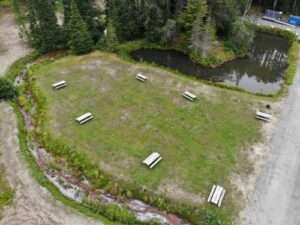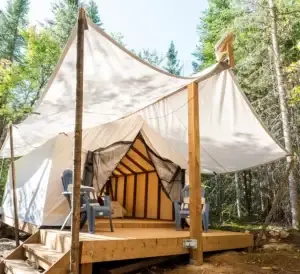 Embark on a journey to Algonquin Park, an expansive natural wonder that I’ve intimately known, thanks to a family heritage spanning over 100 years, having grown up in Whitney, right at its edge. This park, covering over 7,600 square kilometers of Ontario’s wilderness, is more than a destination; it’s a vibrant tapestry of nature’s finest work.
Embark on a journey to Algonquin Park, an expansive natural wonder that I’ve intimately known, thanks to a family heritage spanning over 100 years, having grown up in Whitney, right at its edge. This park, covering over 7,600 square kilometers of Ontario’s wilderness, is more than a destination; it’s a vibrant tapestry of nature’s finest work.
As a local with deep roots in this area, I’ve cherished every moment in Algonquin Park’s embrace. It’s where tranquility meets adventure and has been my personal sanctuary. My connection to the park is profound, centered around becoming one with nature, embracing its explorative and healing qualities. With over 1500 lakes, numerous rivers, and forests, the park offers a serene retreat for those eager to immerse themselves in the great outdoors. Whether you enjoy the peace of quiet canoe trips or the thrill of hiking, there’s something here for everyone.
In this guide, I’ll share with you the secrets of Algonquin Park, insights honed from over a century of my family’s exploration in its vast landscapes. Discover the best trails for hiking, ideal spots for kayaking, and the most picturesque places for swimming. You’ll learn not just what to see and do, but also how to ensure your visit is smooth and enjoyable, even if you’re traveling without a car or camping gear.
My childhood memories are filled with days spent exploring the park’s myriad paths and discovering its hidden corners. Now, I want to help you create your own cherished memories. Whether you’re planning a day trip from a city like Toronto or a more extended stay, I’ll provide practical tips to ensure your experience is as enriching as mine have been.
So, pack your essentials and a map, and get ready to delve into the wonders of Algonquin Park. Whether you’re a seasoned explorer or a first-time visitor, the park welcomes you with open arms. Let’s embark on this journey together, discovering the beauty and tranquility that lies within one of God’s most impressive playgrounds.
 Algonquin Park, nestled in Ontario’s heart, has been an integral part of my life, having grown up in Whitney, its closest neighbor. This guide weaves through the rich history of Algonquin Park, combining its storied past with my personal experiences.
Algonquin Park, nestled in Ontario’s heart, has been an integral part of my life, having grown up in Whitney, its closest neighbor. This guide weaves through the rich history of Algonquin Park, combining its storied past with my personal experiences.
Established in 1893 as Ontario’s first provincial park, Algonquin began as a timber reserve, marking a new era of environmental awareness. This was to protect the rivers’ headwaters flowing from the park, reflecting our evolving relationship with nature.
During my childhood, Algonquin Park was my playground, where I learned to identify various trees, often the white pine. This deepened my appreciation for the park’s diverse flora and fauna. Algonquin is home to a vast array of resilient tree species.
The late 19th and early 20th centuries saw the peak of the logging era, profoundly impacting Algonquin’s landscape and economy. The remnants of this era, like old logging roads and camps, are testaments to the balance between resource utilization and conservation.
A significant event in Algonquin’s history was a massive fire that swept through the park. This destruction, while devastating, gave way to new life and an abundance of wildlife, notably the deer. Post-fire, the park witnessed a surge in deer population, so much so that they were plentiful and approachable, often allowing visitors to walk up to them and even pet and feed them. This period highlights nature’s incredible resilience and ability to regenerate.
By the mid-20th century, the park shifted towards recreation and conservation, focusing on protecting the environment while offering a haven for nature enthusiasts. It became a hub for outdoor activities and biodiversity research.
The Group of Seven artists, including the work of Tom Thompson, found inspiration in Algonquin’s landscapes in the early 20th century. Their art significantly showcased the park’s beauty, contributing to the Canadian art scene.
Today, Algonquin Park is a multifaceted destination, a testament to our journey in understanding and valuing the natural world. Each trail and lake tells a part of this ongoing narrative.
Growing up near Algonquin, I’ve always felt a deep connection to this land. I invite you to explore Algonquin Park with respect and curiosity, where every visit is a step through a richly historic and natural landscape. Welcome to Algonquin Park, a journey through time, nature, and the regenerative power of the wilderness.
See Also: Algonquin Park Museums
Spring (Early May): Early May in Algonquin Park is a hidden gem. The park awakens with rushing rivers, spectacular waterfalls at their peak, and the wilderness emerging in fresh splendor. This is a time with fewer bugs, making outdoor activities more enjoyable. One of the unique spring sights is the moose, often seen alongside the highway, attracted by the salt left over from winter. For fishing enthusiasts, it’s an exciting period as trout season opens, offering excellent angling opportunities.
Summer: The park is vibrantly alive in summer. It’s the perfect backdrop for long hikes and canoe trips on crystal-clear lakes. Wildlife is abundant, and the warm, sunny days extend into beautiful evenings under the stars. Summer nights in Algonquin are especially magical, with clear skies perfect for stargazing and catching meteor showers.
Autumn: Autumn in Algonquin Park is a breathtaking spectacle of colors. The forest transforms into a brilliant canvas of oranges, reds, and yellows. The cooler temperatures and the stunning foliage make this season a favorite for many visitors. Late September to mid-October is usually the best time to witness this colorful display at its prime.
Winter: Algonquin Park in winter is a tranquil, snowy paradise. The landscape is transformed, revealing the rugged beauty of the Canadian Shield rock adorned with impressive ice flows. Wildlife is easier to spot against the sparse, snow-covered backdrop. Winter in the park offers unique experiences like bonfires that are simply otherworldly, providing warmth and a great spot for gathering under the star-filled sky. The clear winter nights are perfect for astronomy enthusiasts, with meteor showers and a brilliant view of the constellations.
Year-Round: No matter the season, the night sky in Algonquin Park is a constant wonder. The lack of light pollution allows for exceptional stargazing opportunities, making every visit a chance to marvel at the universe above.
In every season, Algonquin Park has something special to offer. From the lush life of summer to the serene beauty of winter, each visit is a unique experience. Just remember, respecting the park’s rules is crucial in keeping this magnificent place pristine for future visitors and the wildlife that calls it home.
 A Journey Through on a drive to Algonquin Park is more than just a journey; it’s an immersion into scenic beauty. As you navigate along Highway 60, each turn unravels spectacular views and glimpses of Ontario’s pristine wilderness. The drive itself becomes a prelude to the park’s natural wonders. With your own vehicle, you have the liberty to explore the park’s vast expanse, discovering hidden trails and secluded spots at your own pace.
A Journey Through on a drive to Algonquin Park is more than just a journey; it’s an immersion into scenic beauty. As you navigate along Highway 60, each turn unravels spectacular views and glimpses of Ontario’s pristine wilderness. The drive itself becomes a prelude to the park’s natural wonders. With your own vehicle, you have the liberty to explore the park’s vast expanse, discovering hidden trails and secluded spots at your own pace.
Renting a Car: Freedom on Four Wheels For those in Toronto or Ottawa without a car, renting one offers a perfect solution. Choosing a vehicle that suits your needs, be it for comfort or gear accommodation, enhances your park experience. Car rental services in these cities often provide options tailored for such nature expeditions, ensuring you embark on your journey equipped and ready.
Take ON-400 N towards Barrie; follow ON-400 N through Orillia; merge left ON-11 to ON-60 E in Huntsville. Take the ON-60 exit from ON-11 N; merge onto ON-60 E
Take Trans-Canada Hwy/ON-417 W; continue onto Trans-Canada Hwy/Hwy 17; turn left onto Bruce St/County Rd 20 (signs for County road 20/Renfrew); turn right onto ON-60 W; turn left to stay on ON-60 W; (signs for Eganville); stay on Highway 60 all the way to Algonquin
Your Eco-Friendly Companion If you’re leaning towards a more sustainable travel option, the Parkbus service is your go-to choice. This public transit solution offers direct routes from major cities to the heart of Algonquin Park. It’s not just a ride; it’s an experience, allowing you to soak in the scenic vistas without the worry of navigating traffic or finding parking spots.
For those preferring to experience Algonquin Park without the need for a vehicle, the small community of Whitney serves as an ideal base. Located at the park’s doorstep, it has everything the park has to offer in terms of feel, scenery & wildlife. It offers easy access to several key attractions including Hiking, Biking, Canoeing and Swimming, making it possible to enjoy the essence of Algonquin’s beauty on foot or through local options. Whitney also has everything you need in terms of restaurants and groceries.
 Ready for an unforgettable escape near Algonquin Park? Picture yourself nestled in cozy, quaint accommodations just a stone’s throw away from nature’s splendor. Whether it’s waking up to the serene whispers of the forest, indulging in a lazy afternoon by a sparkling lake, or stargazing into the clear night sky, the area around Algonquin Park offers a delightful mix of rustic charm and modern comforts. So pack your bags (and don’t forget the marshmallows for campfire stories!), because a world of adventure and relaxation awaits! 🌲✨🏡
Ready for an unforgettable escape near Algonquin Park? Picture yourself nestled in cozy, quaint accommodations just a stone’s throw away from nature’s splendor. Whether it’s waking up to the serene whispers of the forest, indulging in a lazy afternoon by a sparkling lake, or stargazing into the clear night sky, the area around Algonquin Park offers a delightful mix of rustic charm and modern comforts. So pack your bags (and don’t forget the marshmallows for campfire stories!), because a world of adventure and relaxation awaits! 🌲✨🏡
Bellwood Inn: A family-operated inn near Algonquin Park’s East Gate, offering cozy, updated rooms with Jacuzzi bathrooms. Bellwood Inn
Dream Catcher Motel: A peaceful motel near the East Gate of Algonquin Park, providing cabin-style accommodations for a serene stay. Dream Catcher Motel
East Gate Motel: Located between downtown Whitney and Algonquin Park’s East Gate, combining traditional charm with modern amenities. East Gate Motel
Rolling Rapids Motel: Situated on the Madawaska River, near the park’s East Gate, offering tranquil waterfront experiences. Rolling Rapids Motel
 Algonquin Park offers a unique camping experience, blending the wilderness of Ontario with modern amenities. The Algonquin Wilderness Campground, launched in 2023, is a notable destination for nature lovers. Located between Algonquin Provincial Park and the town of Whitney, it offers an intimate and evolving camping experience with 15 initial sites. This campground provides modern amenities, including complimentary guest rental programs and the opportunity to earn rewards points for free stays. Plus, every visit includes a free Algonquin Park Day Pass. It’s a place where you can be part of shaping a new attraction while connecting with nature in a special way.
Algonquin Park offers a unique camping experience, blending the wilderness of Ontario with modern amenities. The Algonquin Wilderness Campground, launched in 2023, is a notable destination for nature lovers. Located between Algonquin Provincial Park and the town of Whitney, it offers an intimate and evolving camping experience with 15 initial sites. This campground provides modern amenities, including complimentary guest rental programs and the opportunity to earn rewards points for free stays. Plus, every visit includes a free Algonquin Park Day Pass. It’s a place where you can be part of shaping a new attraction while connecting with nature in a special way.
Each campground in Algonquin Park’s Highway 60 Corridor offers a different experience, from the secluded and primitive to the more developed and busy. Whether you prefer a quiet spot by the lake or a campground with all the amenities, you’ll find something that suits your camping style in Algonquin Park. For more detailed information about these campgrounds, you can visit their official pages on The Friends of Algonquin Park and Ontario Parks.
 Four Corners Algonquin offers a unique and immersive camping and glamping experience near Algonquin Park. They provide a variety of accommodations including safari tents, bubble tents, pole tents, and tiny homes, catering to all levels of camping enthusiasts. Their campground is designed to be inclusive, accessible, and enjoyable for everyone. Four Corners Algonquin focuses on providing a comfortable wilderness stay, complete with rental equipment and a free Algonquin Park day pass. It’s an ideal destination for those seeking both relaxation and adventure, just 4 kilometers from the park. For more details, visit their website: Four Corners Algonquin.
Four Corners Algonquin offers a unique and immersive camping and glamping experience near Algonquin Park. They provide a variety of accommodations including safari tents, bubble tents, pole tents, and tiny homes, catering to all levels of camping enthusiasts. Their campground is designed to be inclusive, accessible, and enjoyable for everyone. Four Corners Algonquin focuses on providing a comfortable wilderness stay, complete with rental equipment and a free Algonquin Park day pass. It’s an ideal destination for those seeking both relaxation and adventure, just 4 kilometers from the park. For more details, visit their website: Four Corners Algonquin.
Bartlett Lodge: An elegant lodge on Cache Lake, known for gourmet dining and unique experiences. Bartlett Lodge
Bondi Cottage Resort: A private retreat on Lake of Bays, with self-contained cottages. Bondi Cottage Resort
Footprints Resort: An adults-only boutique resort offering private accommodations. Footprints Resort
Logging Chain Lodge: A traditional family cottage resort at Dwight Beach on Lake of Bays. Logging Chain Lodge
Pine Cliff Resort: A year-round resort on Madawaska River with cottages and camping. Pine Cliff Resort
Port Cunnington Lodge: A historic lodge on Lake of Bays combining Muskoka charm with luxury. Port Cunnington Lodge
Sunny Hill Resort: Located near Bark Lake, offering cottages and camping facilities. Sunny Hill Resort
These accommodations provide a variety of experiences, from cozy inns and serene motels to luxurious lodges and nature retreats.




Popular Spots Algonquin Park’s Highway 60 corridor stands out as the park’s highlight, offering visitors a scenic route lined with stunning landscapes and wildlife sightings. Key attractions along this corridor include the informative Logging Museum and a captivating Visitor’s Center, which hosts an intriguing movie theatre showcasing films about the park’s natural beauty and history. Additionally, the Lookout Trail offers an accessible and rewarding hike, perfect for beginners seeking breathtaking views.
Hidden Gems The Old Rail Trail in Whitney is a treasure trove for nature lovers. Stretching through picturesque settings, it leads to four stunning waterfalls and the historically significant Whitney Dam. For those seeking a tranquil retreat, the waterfall on Bark Lake offers a serene escape, exemplifying the park’s understated beauty.
Local Culture Algonquin Park’s charm is further enriched by vibrant local festivals. The ‘Winter in the Wild’ festival on Family Day, the quirky ‘Black Fly Festival’ in June, and the ‘Festival of Outdoor Rinks’ at the end of February in Whitney are cultural highlights. Post-Christmas, the Algonquin Park Bird Count adds a unique twist to holiday traditions. Culinary enthusiasts can revel in the delights at the Mad Musher, known for its exceptional local cuisine.
Personal Discovery: The Lookout Trail My journey on the Lookout Trail was a revelation. The path, though moderately challenging, led to an awe-inspiring summit. The panoramic view from the top was a reward in itself, offering a breathtaking vista of Algonquin’s sprawling wilderness. This experience was a testament to the park’s ability to offer both popular attractions and hidden wonders, each with its unique allure.